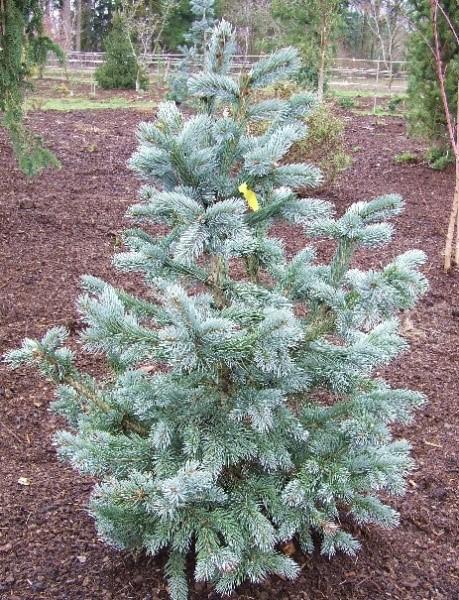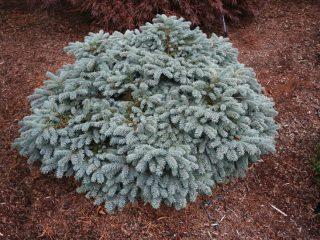Content
Engelmann spruce (lat. Picea Engelmannii) is a beautiful tree with gray-blue or gray needles. It is represented by several varieties that differ in height, shape and color of the needles. The plants are unpretentious and are great for decorating any area.
Description of Engelmann spruce with photo
This tree belongs to the genus of spruce from the pine family. A distinctive feature is its high height (10-20 m, and often 30-50 m) and a very narrow crown. The trunk itself reaches 90 cm in diameter, and the crown can be no more than 1.5-2 m even in tall trees. It is very thick, cone-shaped, and quite often asymmetrical. The branches droop a little.
The bark of Engelmann spruce has a scaly surface, the color is brown with reddish hues. Quite thin, so it often cracks. At the same time, young shoots are lighter, have a yellowish tint and rusty pubescence.
Engelmann spruce needles reach 2-2.5 cm in length and up to 2 mm in width. The shape is tetrahedral, the tips are sharp.The color is bluish-green, with a bluish and even bluish tint. In old trees it is mostly green. Under natural conditions, needles last from 10 to 15 years. When grown in the climatic conditions of Russia, they usually last two times less.
Engelmann spruce cones are ovoid and cylindrical. They reach 5-7 cm in length and half as much in diameter. Initially burgundy in color, as they ripen they become brownish. The scales are flexible, arranged loosely at the edges, and have a jagged shape. They appear en masse from late August to mid-September. They last all winter and fall off early next spring. The seeds are small in size, within 3 mm, very small, the weight of one thousand pieces is only 3 g.

The tree has beautiful needles and a rather narrow crown.
Growing regions
Almost all types of Engelmann spruce tolerate winter frosts down to -34 degrees (without additional shelter), which corresponds to winter hardiness zone 3. They tolerate drought well and grow even in depleted soils. Therefore, they are often found even in rocky areas.
The range is quite wide and includes mixed and coniferous forests of the temperate climate zone. Engelmann spruce can be found everywhere in North America from Canada to the northern regions of Mexico. Especially many of these trees grow in the United States from the Pacific to the Atlantic coasts.
Spruces are found both on the plains and in the foothills. They are often found, including at high altitudes from 1.5 to 3.5 thousand meters above sea level.
The territory of Eurasia, including Russia, is not the natural habitat of this tree.However, here (from the North-West and the middle zone to the Urals, Southern Siberia and the Far East) it is also quite possible to grow various Engelmann spruces.
Types of Engelmann spruce
There are several types of conifer. They differ in both height and crown shape, and partly in color. A description of the most beautiful representatives can be found in the following sections.
Engelmann Glauk spruce
Glauca (Glauca) is a fairly tall tree, often reaching 15-20 m. At the same time, the crown is very narrow, up to 1 m, has a dense structure, and has the shape of a pyramid. The needles of this variety of Engelmann spruce are greenish with a blue tint. The needles are long, reaching 2-2.5 cm. In autumn, brown, egg-shaped cones appear.
It adapts well to different climatic conditions; however, such a tree can only be propagated in June. Looks beautiful as a tapeworm, as well as in group plantings (for example, along an alley). The crown is compact, so seedlings can be placed at intervals of only 1 m.

The Glauc species began to be grown only 10 years ago
Spruce Engelmann Pendula
The Pendula species (Picea engelmannii Pendula) is interesting because its branches droop, so the tree looks like a weeping willow. Gray-blue needles always attract attention. Spruce Engelmann Pendula (Pendula) initially has a small height in the range of 1-1.5 m. But by 25-30 years it reaches 12 m, while it does not spread out in width (within 2.5 m). The crown is quite narrow, the needles are blue.

The Pendula species is often used in single plantings
Engelmann Spruce Snake
Snake has a very sparse crown of an unusual shape, the color of the needles is bluish-blue, in light shades. The Engelmann spruce variety Snake is often used in landscape design for planting in open areas; it looks especially beautiful against the backdrop of a well-groomed lawn.
The height is small. Even at 10 years old, it is only 2 m, while the width of the crown spreads up to 1 m. Mature trees can reach a height of 6 m and a diameter of 3 m. The color of the needles is green with a bluish tint, the needles bend towards the apical part , so the shoots resemble whips.

The Snake species is used to decorate the garden due to its unusually shaped crown.
Engelmann spruce Blue Magu
Blue Magu is one of the most beautiful varieties of Eneglman spruce with blue, even bluish needles. Young shoots hang beautifully from powerful branches, and thanks to their unusual color they look very interesting, especially after the snow has passed.
The crown is narrow, compact, and does not take up much space. The shoots are partly drooping, and from a distance they resemble a “skirt”. The height is small, by the age of 10 the tree reaches only 1.8 m. This variety of Engelmann spruce is quite hardy, so it can be grown both in the middle zone and in Siberia.

The species can withstand frosts down to -34 degrees
Engelmann Spruce Bush Lace
Another weeping variety of Engelmann spruce is Bush’s Lace. The shoots droop, so they look like a “skirt” at the base of the trunk. The growth rate is quite good - by the age of 10 this spruce reaches 4-5 m. The color is bluish, as if covered with snow.
Mature trees can grow up to 7 m. At the same time, the crown is quite narrow and does not spread out, reaching a width of 1.8 m. This allows for fairly dense planting with an interval of 1.5-2 m.Although most often the plant is used as a tapeworm.

The Bush Lace variety can be grown in both sunny and partial shade.
Engelmann Spruce Blue Harbor
Blue Harbor produces a fairly narrow, compact crown that grows predominantly upward rather than outward. The needles are quite long, the color is blue with a grayish tint, the surface is covered with wax. If you touch it, you can feel that it is velvety and quite pleasant. This variety of Engelmann tree is not very tall - by the age of 10 it reaches only 2 m. It is characterized by increased winter hardiness and grows normally even in a polluted atmosphere.

Blue Harbor looks like a real Christmas tree
Engelmann Talbot spruce
This species was first discovered on the coast of Lake Talbot (Canada), which is why it received the appropriate name – Talbot Lake. Spruce grows very slowly, only 3 cm per year or even less. Therefore, even by the age of 10, it acquires a diameter of no more than 25-27 cm.
However, it is precisely because of this feature that the Engelmann spruce species has gained great popularity. Used in rock gardens and other compositions. The needles are blue-green, the shape of the crown is spherical.

Variety Talbot - a very beautiful miniature Christmas tree
Landing rules
Planting Engelmann spruce must be approached with particular care, since due to non-compliance with standard rules, many seedlings may not take root. It is advisable to start planting in the spring, but it is worth preparing the soil in advance. They dig it up, add compost or humus (a bucket per square meter). If the soil is too dense, fill it with sawdust or sand (2-3 kg each).
The place can be chosen either sunny or with partial shade. But completely shady places should be avoided. During landing, proceed as follows:
- Dig a hole deep enough for the roots to fit freely.
- Root the seedling and sprinkle it with fertile soil.
- The soil is compacted a little so that the root collar remains literally 2 cm above ground level.
- Water with settled water.
Care instructions
We can say that Engelmann spruce is an unpretentious plant, but certain care rules must be followed. Experienced summer residents recommend paying attention to several points:
- Young seedlings are watered 2-3 times a week, but mature trees are given water much less often - literally 3-4 times per season, when the soil is very dry.
- Fertilizing is applied once a year, preferably in early spring. To do this, you can use complex mineral fertilizers, for example, Agricola.
- The soil is loosened as necessary; it is very important to do weeding regularly. To ensure that as few weeds grow as possible, lay straw, peat or other mulch.
- In early spring, they begin pruning the Engelmann spruce. It is necessary to remove all old, dried, broken branches.
- As for preparation for winter, only young seedlings need it. They are wrapped in agrofibre and covered with spruce branches or burlap. In early spring, the shelter is removed.

It is enough to feed Engelmann spruce once a year
Reproduction
Reproduction is most often carried out in the following ways:
- Cuttings - in April, several shoots 15 cm long are cut, an oblique lower cut is made. Place it in a solution with Kornevin or another stimulant for several days. Then they are transplanted into a 2:1 mixture of turf soil and peat, covered with a jar, and watered regularly. Next spring they are transplanted to a permanent place.
- From seeds - planting material is disinfected and planted in a container in mid-spring.They put it in a greenhouse, regularly ventilate and water it. The seedlings are transplanted into containers and grown in a cool room in winter. Only after 2-3 years can the seedlings be transferred to open ground.
- Grafting is a rare method of propagation of Engelmann spruce. A shoot 15 cm long is cut off from an adult specimen and grafted into a split on the spruce that grows in a particular region to obtain a winter-hardy plant. This should be done in spring or June.
Diseases and pests
Engelmann spruce does not have good immunity. It can suffer from the following diseases: root rot, rust, fusarium and even ulcerative cancer. Therefore, in early spring it is recommended to carry out treatments with Bordeaux mixture or other preparations:
- "HOM";
- "Maksim";
- "Tattu";
- "Ordan".
Of the pests, the greatest danger to Engelmann spruce are spider mites, aphids and leaf rollers. They are fought with insecticides:
- "Karbofos";
- "Vertimek";
- "Inta-Vir";
- "Decis".
Engelmann spruce in landscape design
The use of Engelmann spruce depends on the height of the tree, the shape of its crown, and the color of the needles. Many representatives look beautiful in single plantings, in open areas, on lawns, near the entrance. Dwarf species are best used in group compositions, for example, in an alpine slide. You can also create an original hedge from them.
Several options for using Engelmann spruce in garden design are shown below:
- Single landing.
- Compositions with other conifers.
- Landing next to the path.
- Single occupancy.
Conclusion
Engelmann spruce is one of the best conifers for decorating a garden. It produces quite a few species, including dwarf and tall ones. Such a tree can be planted next to the entrance and decorated every New Year.You can also make a composition along the alley and decorate it with a garland.
Reviews of Engelmann spruce












